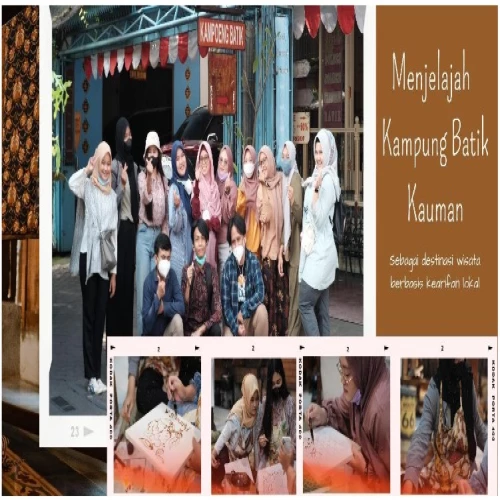Exploring Kauman Batik Village As A Cultural Destination Based On Local Wisdom

Sunday, August 21, 2022, FPIPS UPI Sociology Education students had the opportunity to visit one of the Tourist Villages in Surakarta, namely, Kauman Batik Tourism Village. The visit is one of the destination objects in a series of Kuliah Kerja Lapangan (KKL) activities by group two from 20-22 August 2022 in Surakarta, Central Java. Kauman Batik Tourism Village used to be one of the areas where Abdi Dalem who served in the religious field settled. Batik in Kauman emerged from the wives of scholars who were only housewives and had a lot of free time. Seeing this situation, PB III ordered the wives of scholars to make batik with special training provided by the Palace. From the batik products, craftsmen became batik suppliers in the city of Surakarta and keraton.
The Kauman batik tradition is directly passed down to the descendants of the Courtiers. Since then, Kauman has been synonymous with batik. Because it received expertise from the Kesunanan Palace, it is not surprising that the batik pattern of Kauman Batik Village tends to be classic and authentic with a royal pattern (pakem pattern). Therefore, Kauman Batik Village is said to be the oldest batik center in Surakarta. Kauman Batik from time to time has developed. Until now, Kauman Batik Village has 3 types of batik, namely, batik that uses manual (writing) techniques with classical fashion and pakem patterns which are still superior products Kauman Batik Village. There is also batik with a stamp technique where the stamping tool itself is made of copper stripes then attached to a base and given a handle. So that when the tool is attached to the fabric, print batik patterns in large quantities. In addition, there are also batik fabrics using a combination of stamping and writing techniques, to printing.
There are several small to large batik industries in Kauman Batik Village. One of the most famous and quite old (already 4th generation) is the Gunawan Setiawan Batik shop. When we visited the Gunawan Setiawan Batik shop, we had the opportunity to learn how to make batik writing directly. With a price of 55,000.00 rupiah, visitors can do batik on cloth for 30x30 cm. The shop will provide a variety of patterns ranging from simple batik patterns, floral, fauna, to cartoon characters. Then visitors can print the pattern on a white cloth that has been affixed to the wooden box. After that, visitors also have the opportunity to canting using night (liquid wax as the main ingredient in making batik) provided by the store. In the process of canting requires extra determination and patience. For this reason, for visitors who feel unconfident, they can go directly to the color filling stage. Visitors will be given four primary colors, green; blue; kuing; and red. When color filling, all fabrics must be colored so that the color will not splatter on the other corners or sides of the fabric. Once it's done, visitors can give their work to the officers for the color locking and wax softening stages. Once finished, the results of the batik can be taken home as souvenirs.
In the world
of modern fascison era like this, there are many competing clothing models emerging so that it becomes competitiveness for batik which is one of the components in the world of fasion (in the world of fasion motive-wise). But regardless, batik will still have its own peculiarities. Especially because batik is recognized as the heritage of the Indonesian nation which has been well maintained, so that batik motifs will never change until now. Instead of this, the challenge in this era is, where the younger generation considers that someone uses batik only for formal situations only. With that, craftsmen or designers need to adapt batik motifs to existing modern clothing models, without forgetting their authenticity. So, batik motifs will become a common thing and not just cultural heritage.